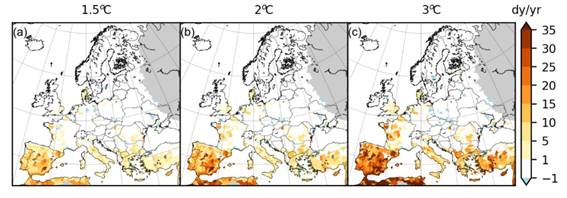Post a comment on the text below
3.3 Abstractions and water scarcity
Overview
Climate change, population growth, urbanisation and intensifying economic activities make water scarcity a critical concern in Europe. Water scarcity refers to long-term water imbalances, combining low water availability with a level of water demand which exceeds the supply capacity of the natural system.[1] In some areas of Europe, water abstractions are characterised by seasonality, adding up to the existing water scarcity drivers of weather phenomena, temperatures, and geographical location (EEA 2019b).
In the second RBMPs of WFD countries[2], around 8 000 surface water bodies (about 6 % of total) were affected by significant pressures from abstraction, with the highest share in Hungary, Spain, Cyprus, and Bulgaria. For around half of these surface water bodies, significant pressures from abstractions are linked to agriculture, while abstractions for public water supply and industry are also major pressures.
Over the last decades, groundwater aquifers have also been affected by overexploitation in many parts of Europe (EEA 2019a). In the second RBMPs, water abstraction was a significant pressure for 17 % of groundwater area in Europe with the highest share in Hungary, Malta and Cyprus. The reported groundwater water abstractions mainly serve public water supply, followed by agriculture and industry.
In 2017, the water consumption in Europe by different economic sector was made up as follows: agriculture (58 %), cooling water for energy production (18 %), mining, quarrying, construction and manufacturing industries (11 %) and households (10%) (EEA 2020).[3] Water consumption refers to the net water abstraction, which is estimated as the difference between the volume of water abstracted and the volume of water returned to the environment before or after use. The average return ratio of water used for cooling lies at around 80 %, while only about 30 % of the total water abstracted for agricultural purposes in Europe returns to the environment (ibid.). The low water return to the environment combined with high water consumption makes agriculture one of the sectors that cause significant pressures on renewable water resources (EEA forthcoming), especially in southern European countries which record up to 80 % of water use for agriculture (EEA 2018a).
Between the year 2000 and 2017, the EU-28 could decrease water abstraction by 17 %, while increasing its Gross Added Value by 59 % in the same period (EEA forthcoming). Despite this positive trend, water scarcity remains a significant issue for many river basins across Europe, especially in the south. Furthermore, drought events are becoming more frequent and intense due to climate change. They are also striking various areas all across Europe, spanning even up to the Arctic circle (EEA, 2020). According to recent projections, an intensification and a longer duration of water scarcity is expected under global warming in the EU, specifically in the Mediterranean countries (Bisselink et al., 2020) (see Figure 12).[4] By 2030, half of the EU’s river basins are expected to experience water scarcity and stress (Trémolet et al. 2019).
Figure 12 Projected change in water scarcity in the EU under global warming

Notes: Projected change in water scarcity days (WEI+ > 20%) in a year compared with present day for a global temperature increase of (a) 1.5oC, (b) 2oC, and (c) 3oC. The results of both the 1.5oC and 2oC warming levels are based on the average of the 11 climate model simulations from both the RCP4.5 and RCP8.5 emission scenarios, while the results of the 3oC warming level are solely based on the 11 simulation of the RCP8.5 emission scenario.
Source(s): Bisselink et al., 2020
[1] https://ec.europa.eu/environment/water/quantity/about.htm
[2] Throughout this report, the term WFD countries has been used to cover the countries that implement the WFD: the 27 EU Member States, Norway and United Kingdom.
[3] EEA, 2020, Indicator Use of Freshwater Resources in Europe, https://www.eea.europa.eu/data-and-maps/indicators/use-of-freshwater-resources-3/assessment-4
[4] JRC Peseta IV, Task 10 report, https://ec.europa.eu/jrc/sites/jrcsh/files/pesetaiv_task_10_water_final_report.pdf
You cannot post comments to this consultation because you are not authenticated. Please log in.



Previous comments
A colleague of mine stresses that also contries around the Nordsee with dense populated areas with a high per capita water use cause water scarcity and the large water comsuption results in groundwater stress.
Is the definition of Water Scarcity the same as in other reports?